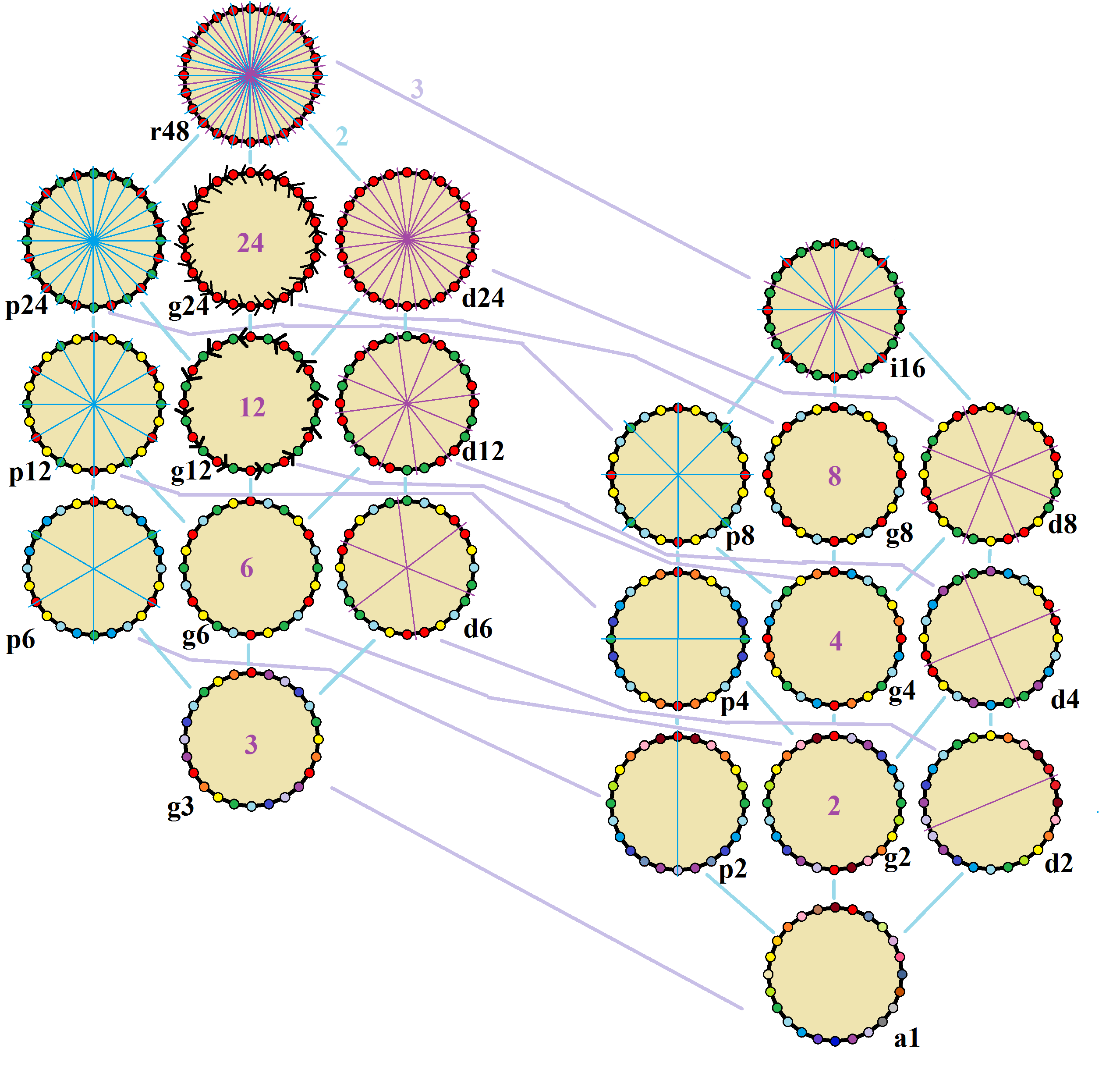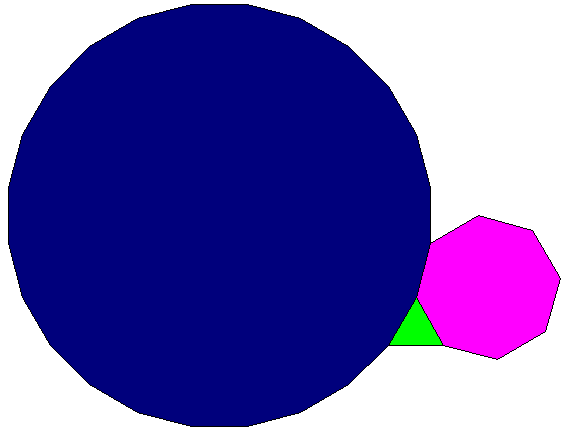icositetragon on:
[Wikipedia]
[Google]
[Amazon]
In
 The ''regular icositetragon'' has Dih24 symmetry, order 48. There are 7 subgroup dihedral symmetries: (Dih12, Dih6, Dih3), and (Dih8, Dih4, Dih2 Dih1), and 8 cyclic group symmetries: (Z24, Z12, Z6, Z3), and (Z8, Z4, Z2, Z1).
These 16 symmetries can be seen in 22 distinct symmetries on the icositetragon. John Conway labels these by a letter and group order. The full symmetry of the regular form is r48 and no symmetry is labeled a1. The dihedral symmetries are divided depending on whether they pass through vertices (d for diagonal) or edges (p for perpendiculars), and i when reflection lines path through both edges and vertices. Cyclic symmetries in the middle column are labeled as g for their central gyration orders.
Each subgroup symmetry allows one or more degrees of freedom for irregular forms. Only the g24 subgroup has no degrees of freedom but can be seen as directed edges.
The ''regular icositetragon'' has Dih24 symmetry, order 48. There are 7 subgroup dihedral symmetries: (Dih12, Dih6, Dih3), and (Dih8, Dih4, Dih2 Dih1), and 8 cyclic group symmetries: (Z24, Z12, Z6, Z3), and (Z8, Z4, Z2, Z1).
These 16 symmetries can be seen in 22 distinct symmetries on the icositetragon. John Conway labels these by a letter and group order. The full symmetry of the regular form is r48 and no symmetry is labeled a1. The dihedral symmetries are divided depending on whether they pass through vertices (d for diagonal) or edges (p for perpendiculars), and i when reflection lines path through both edges and vertices. Cyclic symmetries in the middle column are labeled as g for their central gyration orders.
Each subgroup symmetry allows one or more degrees of freedom for irregular forms. Only the g24 subgroup has no degrees of freedom but can be seen as directed edges.

A regular triangle, octagon, and icositetragon can completely fill a plane vertex. An icositetragram is a 24-sided star polygon. There are 3 regular forms given by
geometry
Geometry (; ) is a branch of mathematics concerned with properties of space such as the distance, shape, size, and relative position of figures. Geometry is, along with arithmetic, one of the oldest branches of mathematics. A mathematician w ...
, an icositetragon (or icosikaitetragon) or 24-gon is a twenty-four-sided polygon
In geometry, a polygon () is a plane figure made up of line segments connected to form a closed polygonal chain.
The segments of a closed polygonal chain are called its '' edges'' or ''sides''. The points where two edges meet are the polygon ...
. The sum of any icositetragon's interior angles is 3960 degrees.
Regular icositetragon
The '' regular icositetragon'' is represented bySchläfli symbol
In geometry, the Schläfli symbol is a notation of the form \ that defines List of regular polytopes and compounds, regular polytopes and tessellations.
The Schläfli symbol is named after the 19th-century Swiss mathematician Ludwig Schläfli, wh ...
and can also be constructed as a truncated dodecagon
In geometry, a dodecagon, or 12-gon, is any twelve-sided polygon.
Regular dodecagon
A regular polygon, regular dodecagon is a figure with sides of the same length and internal angles of the same size. It has twelve lines of reflective symmetry ...
, t, or a twice-truncated hexagon, tt, or thrice-truncated triangle, ttt.
One interior angle in a regular icositetragon is 165°, meaning that one exterior angle would be 15°.
The area
Area is the measure of a region's size on a surface. The area of a plane region or ''plane area'' refers to the area of a shape or planar lamina, while '' surface area'' refers to the area of an open surface or the boundary of a three-di ...
of a regular icositetragon is: (with ''t'' = edge length)
:
The icositetragon appeared in Archimedes' polygon approximation of pi, along with the hexagon (6-gon), dodecagon
In geometry, a dodecagon, or 12-gon, is any twelve-sided polygon.
Regular dodecagon
A regular polygon, regular dodecagon is a figure with sides of the same length and internal angles of the same size. It has twelve lines of reflective symmetry ...
(12-gon), tetracontaoctagon (48-gon), and enneacontahexagon (96-gon).
Construction
As 24 = 23 × 3, a regular icositetragon is constructible using acompass and straightedge
In geometry, straightedge-and-compass construction – also known as ruler-and-compass construction, Euclidean construction, or classical construction – is the construction of lengths, angles, and other geometric figures using only an Idealiz ...
. As a truncated dodecagon
In geometry, a dodecagon, or 12-gon, is any twelve-sided polygon.
Regular dodecagon
A regular polygon, regular dodecagon is a figure with sides of the same length and internal angles of the same size. It has twelve lines of reflective symmetry ...
, it can be constructed by an edge- bisection of a regular dodecagon.
Symmetry
 The ''regular icositetragon'' has Dih24 symmetry, order 48. There are 7 subgroup dihedral symmetries: (Dih12, Dih6, Dih3), and (Dih8, Dih4, Dih2 Dih1), and 8 cyclic group symmetries: (Z24, Z12, Z6, Z3), and (Z8, Z4, Z2, Z1).
These 16 symmetries can be seen in 22 distinct symmetries on the icositetragon. John Conway labels these by a letter and group order. The full symmetry of the regular form is r48 and no symmetry is labeled a1. The dihedral symmetries are divided depending on whether they pass through vertices (d for diagonal) or edges (p for perpendiculars), and i when reflection lines path through both edges and vertices. Cyclic symmetries in the middle column are labeled as g for their central gyration orders.
Each subgroup symmetry allows one or more degrees of freedom for irregular forms. Only the g24 subgroup has no degrees of freedom but can be seen as directed edges.
The ''regular icositetragon'' has Dih24 symmetry, order 48. There are 7 subgroup dihedral symmetries: (Dih12, Dih6, Dih3), and (Dih8, Dih4, Dih2 Dih1), and 8 cyclic group symmetries: (Z24, Z12, Z6, Z3), and (Z8, Z4, Z2, Z1).
These 16 symmetries can be seen in 22 distinct symmetries on the icositetragon. John Conway labels these by a letter and group order. The full symmetry of the regular form is r48 and no symmetry is labeled a1. The dihedral symmetries are divided depending on whether they pass through vertices (d for diagonal) or edges (p for perpendiculars), and i when reflection lines path through both edges and vertices. Cyclic symmetries in the middle column are labeled as g for their central gyration orders.
Each subgroup symmetry allows one or more degrees of freedom for irregular forms. Only the g24 subgroup has no degrees of freedom but can be seen as directed edges.
Dissection
Coxeter states that every zonogon (a 2''m''-gon whose opposite sides are parallel and of equal length) can be dissected into ''m''(''m''-1)/2 parallelograms. In particular this is true for regular polygons with evenly many sides, in which case the parallelograms are all rhombi. For the ''regular icositetragon'', ''m''=12, and it can be divided into 66: 6 squares and 5 sets of 12 rhombs. This decomposition is based on a Petrie polygon projection of a 12-cube.Related polygons

A regular triangle, octagon, and icositetragon can completely fill a plane vertex. An icositetragram is a 24-sided star polygon. There are 3 regular forms given by
Schläfli symbol
In geometry, the Schläfli symbol is a notation of the form \ that defines List of regular polytopes and compounds, regular polytopes and tessellations.
The Schläfli symbol is named after the 19th-century Swiss mathematician Ludwig Schläfli, wh ...
s: , , and . There are also 7 regular star figures using the same vertex arrangement: 2, 3, 4, 6, 8, 3, and 2.
There are also isogonal icositetragrams constructed as deeper truncations of the regular dodecagon
In geometry, a dodecagon, or 12-gon, is any twelve-sided polygon.
Regular dodecagon
A regular polygon, regular dodecagon is a figure with sides of the same length and internal angles of the same size. It has twelve lines of reflective symmetry ...
and dodecagram . These also generate two quasitruncations: t=, and t=. The Lighter Side of Mathematics: Proceedings of the Eugène Strens Memorial Conference on Recreational Mathematics and its History, (1994), ''Metamorphoses of polygons'', Branko Grünbaum
Branko Grünbaum (; 2 October 1929 – 14 September 2018) was a Croatian-born mathematician of Jewish descentskew polygon with 24 vertices and edges but not existing on the same plane. The interior of such an icositetragon is not generally defined. A ''skew zig-zag icositetragon'' has vertices alternating between two parallel planes.
A regular skew icositetragon is vertex-transitive with equal edge lengths. In 3-dimensions it will be a zig-zag skew icositetragon and can be seen in the vertices and side edges of a dodecagonal antiprism with the same D12d, +,24symmetry, order 48. The dodecagrammic antiprism, s and dodecagrammic crossed-antiprism, s also have regular skew dodecagons.
Naming Polygons and Polyhedraicosatetragon
{{polygons Constructible polygons Polygons by the number of sides
Petrie polygons
The regular icositetragon is the Petrie polygon for many higher-dimensional polytopes, seen as orthogonal projections in Coxeter planes, including:References
*Naming Polygons and Polyhedra
{{polygons Constructible polygons Polygons by the number of sides